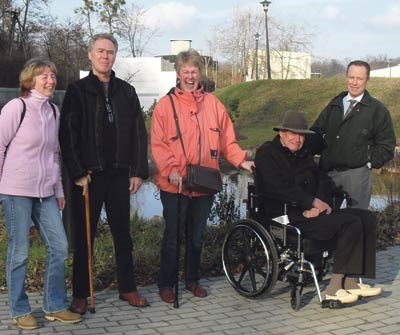Wayne Mogensen said his recent trip to Poland to receive liberation therapy treatment for his multiple sclerosis (MS) didn’t have the effect he would have hoped. But at the very least, it was an “interesting experience,” he said.
Liberation therapy treatment, developed by Italian researcher Dr. Paolo Zamboni in 2009, is a procedure in which MS patients with blockages in their veins are treated using balloon angioplasty. Many MS patients report that after receiving the procedure, their symptoms have abated or even halted altogether.
The procedure is controversial, with many health care professionals questioning its validity, and Zamboni himself saying more clinical trials need to be conducted.
In October, 35-year-old Mahir Mostic of St. Catharines, Ont. died after he received the treatment in Costa Rica, and doctors tried to dissolve a blood-clot complication.

I guess it’s kind of an anticlimax.
Wayne Mogensen,
multiple sclerosis patient
Nevertheless, many Ontario residents have travelled overseas to receive the procedure because it isn’t performed in the province.
Mogensen, a 67-year-old Sudbury resident, only saw a few small improvements to his quality of life after receiving the surgery Nov. 27. Before surgery, he mostly used a wheelchair to get around, something that hasn’t changed.
But he said he’s been able to sleep through the night since the surgery. Before receiving the procedure, he suffered from insomnia, a condition which he suspects was connected to his MS.
“I guess it’s kind of an anticlimax,” especially after hearing about dramatic improvements of other MS patients who have received liberation therapy, he said.
He said he’s been told improvements can appear up to six months after the operation has been performed. Those who have received the surgery are also supposed to get regular physiotherapy, so Mogensen said he’s planning to see a physiotherapist starting in January.
Mogensen said he was aware of the controversial nature of the procedure, as well as Mostic’s death, before travelling to Poland to have surgery.
“I guess you’re always taking a risk, whenever you have surgical procedures, but it might be worth it,” he said.
Mogensen and his wife, Muriel, flew into Warsaw, Poland in late November, and from there travelled to Grodzisk, a small city just west of the Polish capital city. He said the Polish countryside is quite beautiful, even though it was late fall and there were no leaves on the trees when they visited.
The private clinic which performs the liberation therapy treatment rents space in John Paul II Hospital in Grodzisk.
Mogensen stayed in a private room in the hospital, and his wife was able to stay in a hotel room on the hospital’s sixth floor.
Mogensen said his veins were tested before the procedure was performed, and doctors found that both of his jugular veins had blockages.
“When the day for the operation came around, I was able to watch it from the doctor’s screen,” he said.
“I was not under any kind of anesthetic. I was wide awake. It was quite painless, actually...
“I could see a balloon on the end of the wand that they insert into you. They say ‘Now we’re going to inflate the balloon.’ You could feel some pressure on your chest, and you could see the balloon on your screen as it swelled up to remove the obstruction in the veins.”
Mogensen said there were patients from all over the world, including some from Canada, at the hospital receiving the treatment.
“There’s one woman from Great Britain who sent us an e-mail to say that when she goes for walks with her husband now, he can’t keep up with her,” he said. “That is very positive for her. It hasn’t affected me that way. But she must have been walking beforehand.”
The procedure cost Mogensen about $10,000, and travel costs for himself and his wife added up to about $2,000.
Even though he hasn’t been able to dispense with his wheelchair, he recommends the treatment to others who live with MS.
“It’s a great holiday, even if you don’t get any good from it,” he said. “It’s just a very interesting experience...I would have never visited Poland if it hadn’t been for this.”
Laurel Ireland, chair of the Sudbury chapter of the MS Society of Canada, said she knows of eight people from the Sudbury area who have had the liberation therapy operation, although she thinks there’s more out there.
Like MS itself, which affects people in varying ways, the treatment also seems to have a variety of effects, she said.
However, in general, Ireland said the more severe someone’s disability is, the smaller the effect the procedure seems to have.
Those with more severe MS have been subjected to permanent nerve damage, Ireland said.
Their limbs are also weaker because their muscles are wasted from lack of use, she said.
“It’s a treatment, not a cure,” she said.
Ireland said the MS Society of Canada’s position on liberation therapy is that it’s excited about the procedure, but believes more research is needed.
She invites anyone interested in learning about the procedure to come to the MS Society’s Hope Seeker self-help support group meetings.
The meetings are held on the second Monday of each month at the MS Centre of Hope, located at 2750 Bancroft Drive. For more information, phone 705-566-9299.
